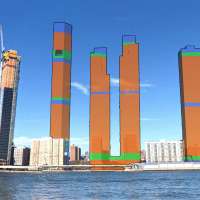The Two Bridges community and its representatives - including Council Member Margaret Chin and Manhattan Borough President Gale Brewer - came out in force to the City Planning Commission (CPC) hearing yesterday to express their opposition to the four megatowers proposed for development along the East River waterfront.
In a neighborhood with a median household income of around $30,000 a year, and where almost no buildings exceed 350 feet in height, these luxury towers would range from about 700 to 1,000 feet tall and bring 2,775 new apartments to the area – over 2,000 of which would be market rate. As countless speakers made clear, the effects of these towers on the community cannot be overstated. As countless speakers attested, it is imperative that the City Planning Commission vote no.
The problems with the proposed towers are myriad, but they ultimately boil down to two things – they will do more harm than good to the existing neighborhood and the city is not following the rules in the way in which they’re even allowing them to be considered.
The central stated purpose of these developments is to bring 694 affordable apartments to the Two Bridges area, advancing the goal of Mayor de Blasio’s Housing New York plan to create or preserve 300,000 affordable units over the next 8 years. But the majority of these affordable units will be out of reach for existing area residents, and the fact that they will be provided through the creation of four times as many market rate units (2,081), in towers wildly out of scale with the neighborhood, serves to counterbalance any benefit these affordable units might bring. These 2,081 market rate units will cause an influx of thousands of higher-income tenants into this low-income neighborhood, with very real displacement effects for both existing tenants and businesses. The City actually acknowledges that new market rate development over the last two decades is contributing to rent increases in the area; what they fail to disclose is that these 2,081 market rate apartments represent more total units than have been built in the entire neighborhood since the year 2000. Their impact on rising rents and displacement pressure cannot be overstated.

The City is able to essentially disregard these impacts by conducting an incomplete displacement analysis that masks the true risk these developments pose. They do this by both overestimating the number of units that are under some form of rent protection – and so, in theory, are free from displacement pressure – and by failing to consider the numerous ways rent protected units can leave protections and cease to be affordable. As numerous local residents shared at the hearing, stabilization does not mean a household isn’t at risk of displacement or doesn’t experience the fear of being driven out of their home. In the immediate Two Bridges neighborhood alone for example, some 950 units have left rent stabilization since 2007, while 300 eviction cases were filed in just the period 2013-2015. In addition, and perhaps most egregiously, the City completely fails to consider the racial impacts of its actions in a neighborhood where over 80% of residents are people of color. These are the households that will be facing the displacement pressures these towers will bring – a fact that cannot be disregarded or ignored.
In addition to the very real concerns as to the impacts of these towers on the community – reason enough on its own for the CPC to vote no – there are legitimate questions as whether the City is even following the rules in the way in which they’re allowing them to be considered. Typically – and without getting too far into the technical details – developments of this scale would be required to go through the Uniform Land Use Review Procedure (ULURP), culminating in a vote by the City Council. Yet in this case, the City has decided ULURP is not required, and a CPC vote of approval is all that’s needed with no opportunity for the community’s elected representatives to hold a vote. This only fuels the feeling among community members that these buildings are being rammed through against the wishes, and to the direct detriment, of existing residents.
This is even more notable given the fact that the Chinatown, Two Bridges, and Lower East Side community spent years creating their own community-driven plan for the future of their neighborhoods through the Chinatown Working Group – culminating in The Plan for Chinatown and Surrounding Areas: Preserving Affordability & Authenticity. This plan includes a vision for the Two Bridges waterfront that stands in stark contrast to the proposed towers – a plan that, notably, would allow the same amount of development potential as exists today, but with heights and affordability levels that better serve the neighborhood. This is a plan the City has ignored in allowing these proposed towers to move forward.
It may be easy for the City and the CPC to dismiss most of the community’s complaints as NIMBYism or a fear of new development, but it’s important to acknowledge some of the crucial distinctions here. The Chinatown, Two Bridges, and Lower East Side neighborhoods have been historic immigrant neighborhoods for centuries and continue to be so today. They are diverse, vibrant, and inclusive neighborhoods. What the community is fighting for is to keep it that way – not to keep people and development out, but to keep it a neighborhood that is welcoming to all, including, vitally, the most vulnerable. That has to be recognized and respected. The proposed towers are a threat to the community and the City Planning Commission must vote no.